
- Homepage
- Binding
- 1 / 2 Leather (2)
- 3 / 4 Leather (2)
- Brochure / Pamphlet (4)
- Cloth (87)
- Disbound (3)
- Fine Binding (52)
- Hard Back (2)
- Hard Cover (4)
- Hardback (6)
- Hardcover (893)
- Hardcover Sheepskin (2)
- Hardcover W / Jacket (5)
- Hardcovers (2)
- Leather (259)
- Original Blue Cloth (2)
- Quarter Leather (3)
- Softcover (3)
- Softcover, Wraps (42)
- ... (3553)
- Language
- Region
- Subject
- American History (7)
- Americana (79)
- Art & Photography (7)
- Bible (12)
- Children's (4)
- Civil War (60)
- Exploration & Travel (5)
- Fashion & Costumes (4)
- Figures & Portraits (19)
- Historic & Vintage (10)
- History (255)
- Illustrated (7)
- Literature & Fiction (37)
- Men, Civil War (8)
- Military (20)
- Military & Political (131)
- Military & War (644)
- New York (4)
- Reference (19)
- Science & Medicine (8)
- ... (3586)
- Topic
- American (us) (22)
- American Civil War (14)
- American History (4)
- Atlases (4)
- Bible (5)
- Christianity, Bibles (97)
- Christmas (4)
- Civil War (50)
- Civil War (1861-65) (894)
- Classics (6)
- Essays & Speeches (3)
- Grant (3)
- Historical (34)
- Literature (5)
- Military (24)
- Plantation Life (6)
- Religion (6)
- The Civil War (4)
- U.s. Grant (13)
- United States (30)
- ... (3698)
- Year Printed
LEATHER SetCIVIL WAR! United States Lincoln Grant(FIRST EDITION! 1863)RARE! GIFT
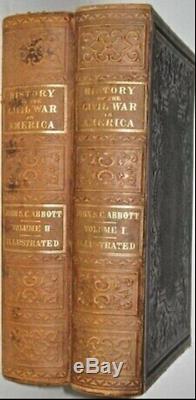
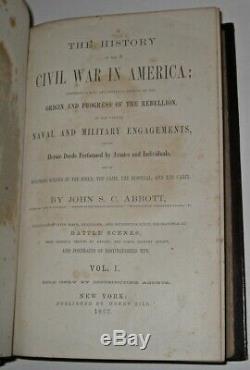

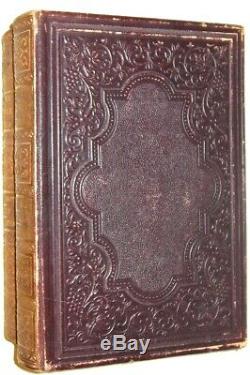


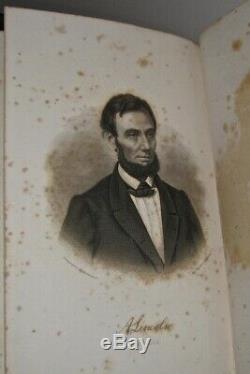
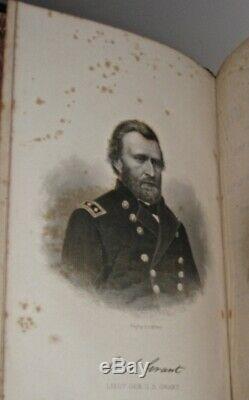
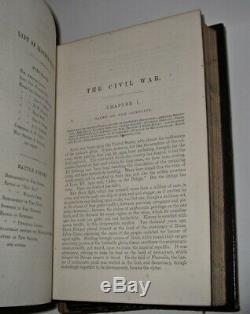
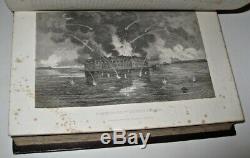
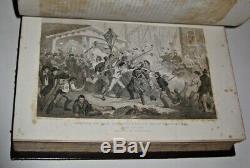


A HISTORY OF THE CIVIL WAR! THE HISTORY OF THE CIVIL WAR IN AMERICA.
This is the First historical account of the Civil War. The first volume was printed during the war itself, in 1863.
With the final volume in 1866. This is the Rare FIRST account of the Civil War. Headley's'Great Rebellion', printed in 1864. THE HISTORY OF THE CIVIL WAR IN AMERICA Comprising a full and impartial account of the Origin and Progress of the Rebellion, of the various Naval and Military Engagements, of the Heroic Deeds Performed by Armies and Individuals, and of Touching Scenes in the Field, the camp, the Hospital, and the Cabin. Illustrated with maps, diagrams, and numerous steel engravings of Battle Scenes, from original designs by Darley, and other eminent artists, and portraits of distinguished men.
Printed in 1863 - 1866. This set is Over 150 YEARS OLD!
First Editions from the Civil War are becoming increasingly scarce. Bound in the original, full morocco leather bindings!
Full leather bindings such as these, were very costly to produce, and are exceptionally desirable! Decorative floral tooling and intricate embossing. These are large, heavy books at 10 inches tall and particularly thick. Published by Gurdon Bill, Springfield, Mass. Volume I 1863, volume II, 1866. CONDTION: Complete in 2 large volumes. Very Good condition, with some general shelf wear and abrasions.Leather is rugged and supple. Hinges fully attached and sound with extremity starting to volume two, but held very strong. Leather is supple and very fresh. Tissue paper present over plates.
No previous signs of ownership. All text present and clear. A gorgeous and impressive set. Each volume includes a frontis protected by tissue, a preface and numerous stunning, high quality, steel-engraved plates. An important history of the American Civil War, and an important piece of Americana.This would make an excellent gift and/or addition to any fine library. Antiquarian books make a great investment, are only going up in value, and are sure to increase the aura of any room or office!
All books are individually wrapped and professionally padded. With volume one printed during the Civil War. Published even as the war continued, with the second volume completed after the war. Printed in 1863 and 1866, respectively. This set is over 150 years old!
This is a gorgeous set! Bound in the original, full leather bindings. With numerous fine STEEL ENGRAVED plates!
Complete in 2 volumes, as stated on the title pages. Bound in full leather bindings. Full leather bindings were more expensive to produce and are highly desirable.
The hinges are all 100% fully attached. These are the original bindings. Intricately gilded and embossed spines. The hinges are all fully attached and strong. These are the original bindings, over 150 years old. From Wikipedia, the free encyclopedia. For other people named John Abbott, see John Abbott (disambiguation). June 17, 1877 (aged 71). Historian, pastor, and pedagogical writer.John Stevens Cabot Abbott (September 19, 1805 June 17, 1877), an American historian, pastor, and pedagogical writer, was born in Brunswick, Maine. To Jacob and Betsey Abbott.
He was a brother of Jacob Abbott. And was associated with him in the management of Abbott's Institute. New York City, and in the preparation of his series of brief historical biographies. Abbott graduated at Bowdoin College.
In 1825, prepared for the ministry at Andover Theological Seminary. And between 1830 and 1844, when he retired from the ministry in the Congregational Church. Owing to the success of a little work, The Mother at Home , he devoted himself, from 1844 onwards, to literature. He was a voluminous writer of books on Christian ethics, and of popular histories, which were credited with cultivating a popular interest in history. He is best known as the author of the widely popular History of Napoleon Bonaparte. (1855), in which the various elements and episodes in Napoleon's career are described. Abbott takes a very favourable view towards his subject throughout.Also among his principal works are: History of the Civil War. In America (18631866), and The History of Frederick II, Called Frederick the Great. He also did a foreword to a book called Life of Boone by W.
In general, except that he did not write juvenile fiction, his work in subject and style closely resembles that of his brother, Jacob Abbott. On August 17, 1830 he married Jane Williams Bourne, daughter of Abner Bourne and Abagail Williams. Together they raised nine children. John Brown Abbott (November 29, 1831 May 24, 1839). Jane Maria Abbott (born November 25, 1833).Waldo Abbott (September 8, 1836 July 7, 1864). Harriet Vaughan Abbott (born February 18, 1838). Ellen Williams Abbott(born January 11, 1840). Laura Sallucia Abbott (born October 30, 1843).
Elizabeth Ballister Abbott (March 15, 1847 February 23, 1864). Emma Susan Abbott (born July 12, 1849). Gorham Dummer Abbott (born March 29, 1851).
As a part of the 1872 Iwakura Mission. Abbott was given guardianship of Shige Nagai. A Japanese girl sent to the United States to be educated. Abbott died at Fair Haven, Connecticut.
In 1910, a series of twenty short biographies of historical characters by J. And Jacob Abbott, was published. Their brother, Gorham Dummer Abbott. Abbott's grandson, Willis Abbott, was a Christian Scientist.And an editor of the Christian Science Monitor. The Mother At Home c. The Path of Peace (1836). The Child At Home (1834). The history of Christianity : consisting of the life and teachings of Jesus of Nazareth : the adventures of Paul and the apostles and the most interesting events in the progress of Christianity from the earliest period to the present time (1872).
The History of Napoleon Bonaparte (1855). The French Revolution of 1789 (1859). The History of the Civil War in America (Volume I published 1864, Volume II published 1866). Prussia and the Franco-Prussian War (1871). The History of The State of Ohio (1875).
Published after 1850 in the series Illustrated History , with other titles by his brother Jacob Abbott. Later reissued in the Famous Characters of History series, and in the 1904 series Makers of History. War chief of the Wampanoag people. Elder brother of Napoleon Bonaparte.The last king to rule France, although Emperor Napoleon III. Would serve as its last monarch. For other uses, see Civil War (disambiguation).
Clockwise from top: Battle of Gettysburg. (4 years, 3 weeks and 6 days).
Dissolution of the Confederate States. Beginning of the Reconstruction era. Passage and ratification of the 13th, 14th and 15th amendments. To the Constitution of the United States. 110,000+ killed in action/died of wounds.
25,00030,000 died in Confederate prisons. 94,000+ killed in action/died of wounds. 26,00031,000 died in Union prisons. 50,000 free civilians dead. 80,000+ slaves dead (disease).Theaters of the American Civil War. Nat Turner's slave rebellion. American Slavery As It Is.
Fugitive Slave Act of 1850. The Impending Crisis of the South. Brown's raid on Harpers Ferry. President Lincoln's 75,000 volunteers.The American Civil War also known by other names. Fought in the United States.
From 1861 to 1865, between the North. The most studied and written about.The Civil War began primarily as a result of the long-standing controversy. Over the enslavement of black people. War broke out in April 1861 when secessionist. As the President of the United States. The loyalists of the Union.
In the North, which also included some geographically western and southern states, proclaimed support for the Constitution. They faced secessionists of the Confederate States. In the South, who advocated for states' rights.
In February 1861, seven Southern slave states. Were declared by partisans to have seceded from the country, and a Confederate States of America. Was organized in rebellion against the U. The Confederacy grew to control at least a majority of territory in eleven states, and it claimed the additional states of Kentucky and Missouri by assertions from native secessionists fleeing Union authority.But without territory or population therein; these states were given full representation in the Confederate Congress throughout the Civil War. The two remaining slave states, Delaware and Maryland, were invited to join the Confederacy, but nothing substantial developed due to intervention.
The Confederate States was never diplomatically recognized by the government of the United States. Or by that of any foreign country. The states that remained loyal to the U.
Were known as the Union. The Union and the Confederacy quickly raised volunteer and conscription armies that fought mostly in the South over the course of four years. Intense combat left 620,000 to 750,000 people dead, more than the number of U. Military deaths in all other wars combined.April 9, 1865 when General Robert E. At the Battle of Appomattox Court House. Confederate generals throughout the southern states followed suit, the last surrender on land occurring June 23. Much of the South's infrastructure was destroyed, especially the transportation systems.
And four million black slaves were freed. That followed the war, national unity was slowly restored, the national government expanded its power, and civil and political rights. Were granted to freed black slaves through amendments to the Constitution. Attitude of the border states. General features of the War.
Sherman's March to the Sea. The Waterloo of the Confederacy.
Slavery as a war issue. In works of culture and art. In the 1860 presidential election. Supported banning slavery in all the U.The Southern states viewed this as a violation of their constitutional rights, and as the first step in a grander Republican plan to eventually abolish slavery. The three pro-Union candidates together received an overwhelming 82% majority of the votes cast nationally: Republican Lincoln's votes centered in the north, Democrat. Votes were distributed nationally and Constitutional Unionist.
S votes centered in Tennessee. The Republican Party, dominant in the North, secured a plurality. Of the popular votes and a majority of the electoral votes nationally; thus Lincoln was constitutionally elected president. He was the first Republican Party candidate to win the presidency. Seven slave states with cotton.
Based economies declared secession and formed the Confederacy. The first six to declare secession had the highest proportions of slaves in their populations, with an average of 49 percent. Of those states whose legislatures resolved for secession, the first seven voted with split majorities for unionist candidates Douglas and Bell Georgia.
With 55%, or with sizable minorities for those unionists Alabama. With 25%, and South Carolina. Votes without a popular vote for president. Of these, only Texas held a referendum on secession.
Eight remaining slave states continued to reject calls for secession. Outgoing Democratic President James Buchanan. And the incoming Republicans rejected secession as illegal. Lincoln's March 4, 1861, inaugural address.
Declared that his administration would not initiate a civil war. Speaking directly to the "Southern States", he attempted to calm their fears of any threats to slavery, reaffirming, I have no purpose, directly or indirectly to interfere with the institution of slavery in the United States where it exists. I believe I have no lawful right to do so, and I have no inclination to do so. After Confederate forces seized numerous federal forts within territory claimed by the Confederacy, efforts at compromise failed and both sides prepared for war.
The Confederates assumed that European. Countries were so dependent on King Cotton. But none did, and none recognized the new Confederate States of America.
Hostilities began on April 12, 1861, when Confederate forces fired upon Fort Sumter. While in the Western Theater. The Union made significant permanent gains, in the Eastern Theater.
The battle was inconclusive during 18611862. Later, in September 1862, Lincoln issued the Emancipation Proclamation. Which made ending slavery a war goal. To the west, by summer 1862 the Union destroyed the Confederate river navy, then much of its western armies, and seized New Orleans.
The successful 1863 Union siege of Vicksburg. Split the Confederacy in two at the Mississippi River. S Confederate incursion north ended at the Battle of Gettysburg. Western successes led to Ulysses S. S command of all Union armies in 1864.
Inflicting an ever-tightening naval blockade. Of Confederate ports, the Union marshaled the resources and manpower to attack the Confederacy from all directions, leading to the fall of Atlanta.
And his march to the sea. The last significant battles raged around the Siege of Petersburg. Lee's escape attempt ended with his surrender at Appomattox Court House.
While the military war was coming to an end, the political reintegration of the nation was to take another 12 years, known as the Reconstruction era. Confederate flag, the "Stars and Bars". The American Civil War was among the earliest industrial wars.
Ships, and mass-produced weapons were employed extensively. The mobilization of civilian factories, mines, shipyards, banks, transportation, and food supplies all foreshadowed the impact of industrialization in World War I. It remains the deadliest war in American history. From 1861 to 1865, it is estimated that 620,000 to 750,000 soldiers died.
Along with an undetermined number of civilians. By one estimate, the war claimed the lives of 10 percent of all Northern men 2045 years old, and 30 percent of all Southern white men aged 1840.
Main articles: Origins of the American Civil War. And Timeline of events leading to the American Civil War. The causes of secession were complex and have been controversial since the war began, but most academic scholars identify slavery as a central cause of the war. Bradford wrote that the issue has been further complicated by historical revisionists. Who have tried to offer a variety of reasons for the war. Slavery was the central source of escalating political tension in the 1850s. Was determined to prevent any spread of slavery, and many Southern leaders had threatened secession if the Republican candidate, Lincoln. After Lincoln won, many Southern leaders felt that disunion was their only option, fearing that the loss of representation would hamper their ability to promote pro-slavery acts and policies.Status of the states, 1861. States that seceded before April 15, 1861. States that seceded after April 15, 1861. Union states that permitted slavery. Union states that banned slavery.
Slavery was a major cause of disunion. Although there were opposing views even in the Union States. Most northern soldiers were mostly indifferent on the subject of slavery. While Confederates fought the war mainly to protect a southern society of which slavery was an integral part. From the anti-slavery perspective, the issue was primarily about whether the system of slavery was an anachronistic evil that was incompatible with republicanism.
The strategy of the anti-slavery forces was containmentto stop the expansion and thus put slavery on a path to gradual extinction. The slave-holding interests in the South denounced this strategy as infringing upon their Constitutional rights.Southern whites believed that the emancipation of slaves would destroy the South's economy, due to the large amount of capital invested in slaves and fears of integrating the ex-slave black population. In particular, Southerners feared a repeat of "the horrors of Santo Domingo". In which nearly all white people including men, women, children, and even many sympathetic to abolition were killed after the successful slave revolt in Haiti. Historian Thomas Fleming points to the historical phrase "a disease in the public mind" used by critics of this idea, and proposes it contributed to the segregation in the Jim Crow.
These fears were exacerbated by the recent attempt. To instigate an armed slave rebellion in the South. Slavery was illegal in much of the North, having been outlawed in the late 18th and early 19th centuries.
It was also fading in the border states and in Southern cities, but it was expanding in the highly profitable cotton districts of the rural South and Southwest. Subsequent writers on the American Civil War looked to several factors explaining the geographic divide.
Further information: Slave states and free states. At first, the new states carved out of these territories entering the union were apportioned equally between slave and free states. Pro- and anti-slavery forces collided over the territories west of the Mississippi. With the conquest of northern Mexico.In 1848, slaveholding interests looked forward to expanding into these lands and perhaps Cuba and Central America as well. Northern "free soil" interests vigorously sought to curtail any further expansion of slave territory. Over California balanced a free-soil state with stronger fugitive slave laws for a political settlement after four years of strife in the 1840s.
But the states admitted following California were all free: Minnesota (1858), Oregon (1859) and Kansas (1861). In the Southern states the question of the territorial expansion of slavery westward again became explosive. Both the South and the North drew the same conclusion: The power to decide the question of slavery for the territories was the power to determine the future of slavery itself. Stephen Douglas, author of the KansasNebraska Act. Crittenden, of the 1860 Crittenden Compromise. By 1860, four doctrines had emerged to answer the question of federal control in the territories, and they all claimed they were sanctioned by the Constitution, implicitly or explicitly. The first of these "conservative" theories, represented by the Constitutional Union Party. Argued that the Missouri Compromise. Apportionment of territory north for free soil and south for slavery should become a Constitutional mandate. Of 1860 was an expression of this view. The second doctrine of Congressional preeminence, championed by Abraham Lincoln and the Republican Party, insisted that the Constitution did not bind legislators to a policy of balancethat slavery could be excluded in a territory as it was done in the Northwest Ordinance. Of 1787 at the discretion of Congress. Thus Congress could restrict human bondage, but never establish it. Announced this position in 1846. Proclaimed the doctrine of territorial or "popular" sovereigntywhich asserted that the settlers in a territory had the same rights as states in the Union to establish or disestablish slavery as a purely local matter. Of 1854 legislated this doctrine. In the Kansas Territory, years of pro and anti-slavery violence. And political conflict erupted; the congressional House of Representatives voted to admit Kansas as a free state in early 1860, but its admission in the Senate was delayed until January 1861, after the 1860 elections when Southern states began to leave. The fourth theory was advocated by Mississippi Senator Jefferson Davis. One of state sovereignty ("states' rights"). Also known as the "Calhoun doctrine". Named after the South Carolinian political theorist and statesman John C. Rejecting the arguments for federal authority or self-government, state sovereignty would empower states to promote the expansion of slavery as part of the federal union under the U. "States' rights" was an ideology formulated and applied as a means of advancing slave state interests through federal authority.Krannawitter points out, the Southern demand for federal slave protection represented a demand for an unprecedented expansion of federal power. These four doctrines comprised the dominant ideologies presented to the American public on the matters of slavery, the territories, and the U. Constitution before the 1860 presidential election. The South argued that just as each state had decided to join the Union, a state had the right to secedeleave the Unionat any time.
Northerners (including President Buchanan) rejected that notion as opposed to the will of the Founding Fathers. Who said they were setting up a perpetual union. Historian James McPherson writes concerning states' rights and other non-slavery explanations. While one or more of these interpretations. Remain popular among the Sons of Confederate Veterans. And other Southern heritage groups, few professional historians now subscribe to them. Of all these interpretations, the states'-rights argument is perhaps the weakest.It fails to ask the question, states' rights for what purpose? States' rights, or sovereignty, was always more a means than an end, an instrument to achieve a certain goal more than a principle. Regional tensions came to a head during the War of 1812. Resulting in the Hartford Convention.
Which manifested Northern dissastisfaction with a foreign trade embargo that affected the industrial North disproportionately, the Three-Fifths Compromise. Dilution of Northern power by new states, and a succession of Southern presidents.Sectionalism increased steadily between 1800 and 1860 as the North, which phased slavery out of existence, industrialized, urbanized, and built prosperous farms, while the deep South concentrated on plantation agriculture based on slave labor, together with subsistence agriculture. In the 1840s and 50s, the issue of accepting slavery (in the guise of rejecting slave-owning bishops and missionaries) split the nation's largest religious denominations (the Methodist, Baptist, and Presbyterian churches) into separate Northern and Southern denominations. Historians have debated whether economic differences between the mainly industrial North and the mainly agricultural South helped cause the war. Most historians now disagree with the economic determinism.
In the 1920s, and emphasize that Northern and Southern economies were largely complementary. While socially different, the sections economically benefited each other. Slave owners preferred low-cost manual labor with no mechanization. Northern manufacturing interests supported tariffs and protectionism while southern planters demanded free trade. The Democrats in Congress, controlled by Southerners, wrote the tariff laws in the 1830s, 1840s, and 1850s, and kept reducing rates so that the 1857 rates were the lowest since 1816. The Republicans called for an increase in tariffs in the 1860 election. The increases were only enacted in 1861 after Southerners resigned their seats in Congress.The tariff issue was a Northern grievance. Writers have claimed it as a Southern grievance. In 186061 none of the groups that proposed compromises to head off secession raised the tariff issue. Pamphleteers North and South rarely mentioned the tariff.
Nationalism was a powerful force in the early 19th century, with famous spokesmen such as Andrew Jackson. While practically all Northerners supported the Union, Southerners were split between those loyal to the entire United States (called "unionists") and those loyal primarily to the southern region and then the Confederacy. Said of the latter group. Had grown up and miraculously flourished in the heart of a thoroughly bourgeois and partly puritanical republic.
It had renounced its bourgeois origins and elaborated and painfully rationalized its institutional, legal, metaphysical, and religious defenses... When the crisis came it chose to fight. It proved to be the death struggle of a society, which went down in ruins.
Perceived insults to Southern collective honor included the enormous popularity of Uncle Tom's Cabin. And the actions of abolitionist John Brown. In trying to incite a slave rebellion. While the South moved towards a Southern nationalism, leaders in the North were also becoming more nationally minded, and they rejected any notion of splitting the Union. The Republican national electoral platform of 1860 warned that Republicans regarded disunion as treason.
And would not tolerate it: We denounce those threats of disunion... As denying the vital principles of a free government, and as an avowal of contemplated treason, which it is the imperative duty of an indignant people sternly to rebuke and forever silence. The South ignored the warnings: Southerners did not realize how ardently the North would fight to hold the Union together.
Main article: 1860 United States presidential election. The election of Abraham Lincoln in November 1860 was the final trigger for secession.
Efforts at compromise, including the Corwin Amendment. Southern leaders feared that Lincoln would stop the expansion of slavery and put it on a course toward extinction.
The slave states, which had already become a minority in the House of Representatives, were now facing a future as a perpetual minority in the Senate and Electoral College against an increasingly powerful North. Before Lincoln took office in March 1861, seven slave states had declared their secession and joined to form the Confederacy. According to Lincoln, the people had shown that they can be successful in establishing and administering a republic, but a third challenge faced the nation, maintaining a republic based on the people's vote against an attempt to overthrow it. The election of Lincoln provoked the legislature of South Carolina to call a state convention to consider secession. Prior to the war, South Carolina did more than any other Southern state to advance the notion that a state had the right to nullify.
Federal laws, and even to secede from the United States. The convention summoned unanimously voted to secede on December 20, 1860, and adopted the Declaration of the Immediate Causes Which Induce and Justify the Secession of South Carolina from the Federal Union. It argued for states' rights for slave owners in the South, but contained a complaint about states' rights in the North in the form of opposition to the Fugitive Slave Act.
Claiming that Northern states were not fulfilling their federal obligations under the Constitution. The "cotton states" of Mississippi, Florida, Alabama, Georgia, Louisiana, and Texas followed suit, seceding in January and February 1861.
The first published imprint of secession, a broadside. Issued by the Charleston Mercury. Among the ordinances of secession passed by the individual states, those of threeTexas, Alabama, and Virginiaspecifically mentioned the plight of the "slaveholding states" at the hands of northern abolitionists. The rest make no mention of the slavery issue, and are often brief announcements of the dissolution of ties by the legislatures.However, at least four statesSouth Carolina. Also passed lengthy and detailed explanations of their causes for secession, all of which laid the blame squarely on the movement to abolish slavery and that movement's influence over the politics of the northern states.
The southern states believed slaveholding was a constitutional right because of the Fugitive Slave Clause. These states agreed to form a new federal government, the Confederate States of America.
They took control of federal forts and other properties within their boundaries with little resistance from outgoing President James Buchanan. Whose term ended on March 4, 1861. Buchanan said that the Dred Scott decision.Was proof that the South had no reason for secession, and that the Union "was intended to be perpetual", but that "The power by force of arms to compel a State to remain in the Union" was not among the "enumerated powers granted to Congress". One quarter of the U. Armythe entire garrison in Texaswas surrendered in February 1861 to state forces by its commanding general, David E. Who then joined the Confederacy.
As Southerners resigned their seats in the Senate and the House, Republicans were able to pass bills for projects that had been blocked by Southern Senators before the war. These included the Morrill Tariff. Land grant colleges the Morrill Act. A transcontinental railroad the Pacific Railroad Acts.And the authorization of United States Notes. By the Legal Tender Act of 1862.
The Revenue Act of 1861. To help finance the war. On December 18, 1860, the Crittenden Compromise. Was proposed to re-establish the Missouri Compromise. Line by constitutionally banning slavery in territories to the north of the line while guaranteeing it to the south. The adoption of this compromise likely would have prevented the secession of every southern state apart from South Carolina, but Lincoln and the Republicans rejected it. It was then proposed to hold a national referendum on the compromise. The Republicans again rejected the idea, although a majority of both Northerners and Southerners would have voted in favor of it.A pre-war February Peace Conference of 1861. Met in Washington, proposing a solution similar to that of the Crittenden compromise, it was rejected by Congress. The Republicans proposed an alternative compromise. To not interfere with slavery where it existed but the South regarded it as insufficient. Nonetheless, the remaining eight slave states rejected pleas to join the Confederacy following a two-to-one no-vote in Virginia's First Secessionist Convention on April 4, 1861.
President of the Confederate States of America. On March 4, 1861, Abraham Lincoln.Was sworn in as President. He argued that the Constitution was a more perfect union.
Than the earlier Articles of Confederation and Perpetual Union. That it was a binding contract, and called any secession "legally void". He had no intent to invade Southern states, nor did he intend to end slavery where it existed, but said that he would use force to maintain possession of Federal property. Where popular conditions did not allow peaceful enforcement of Federal law, U.Marshals and judges would be withdrawn. No mention was made of bullion lost from U.
Mints in Louisiana, Georgia, and North Carolina. He stated that it would be U. His speech closed with a plea for restoration of the bonds of union, famously calling on "the mystic chords of memory" binding the two regions.
The South sent delegations to Washington and offered to pay for the federal properties. And enter into a peace treaty with the United States. Lincoln rejected any negotiations with Confederate agents because he claimed the Confederacy was not a legitimate government, and that making any treaty with it would be tantamount to recognition of it as a sovereign government. Secretary of State William Seward. Who at the time saw himself as the real governor or "prime minister" behind the throne of the inexperienced Lincoln, engaged in unauthorized and indirect negotiations that failed. President Lincoln was determined to hold all remaining Union-occupied forts in the Confederacy: Fort Monroe. In Florida, and Fort Sumter. Located at the cockpit of secession in Charleston, South Carolina. Main article: Battle of Fort Sumter.The Confederate "Stars and Bars" flying from Fort Sumter. Fort Sumter was located in the middle of the harbor of Charleston.
Its garrison recently moved there to avoid incidents with local militias in the streets of the city. Anderson to hold on until fired upon. Jefferson Davis ordered the surrender of the fort. Anderson gave a conditional reply that the Confederate government rejected, and Davis ordered General P. To attack the fort before a relief expedition could arrive. He bombarded Fort Sumter on April 1213, forcing its capitulation. The attack on Fort Sumter rallied the North to the defense of American nationalism. Underscored the significance of the event. The thunderclap of Sumter produced a startling crystallization of Northern sentiment.From every side came news of mass meetings, speeches, resolutions, tenders of business support, the muster of companies and regiments, the determined action of governors and legislatures. Mass meeting in New York City April 20, 1861, to support the Union. Union leaders incorrectly assumed that only a minority of Southerners were in favor of secession and that there were large numbers of southern Unionists that could be counted on. Had Northerners realized that most Southerners favored secession, they might have hesitated at attempting the enormous task of conquering a united South. Lincoln called on all the states to send forces to recapture the fort and other federal properties.
The scale of the rebellion appeared to be small, so he called for only 75,000 volunteers. The governor of Massachusetts had state regiments on trains headed south the next day. In western Missouri, local secessionists seized Liberty Arsenal. On May 3, 1861, Lincoln called for an additional 42,000 volunteers for a period of three years. Four states in the middle and upper South had repeatedly rejected Confederate overtures, but now Virginia.Refused to send forces against their neighbors, declared their secession, and joined the Confederacy. To reward Virginia, the Confederate capital was moved to Richmond. Main article: Border states (American Civil War).
Union territories not permitting slavery. Border Union states, permitting slavery. One of these states, West Virginia. Union territories that permitted slavery (claimed by Confederacy) at the start of the war, but where slavery was outlawed by the U. Were slave states that were opposed to both secession and coercing the South.
Then joined them as an additional border state after it separated from Virginia. And became a state of the Union. Maryland's territory surrounded the United States' capital of Washington, DC.
And could cut it off from the North. It had numerous anti-Lincoln officials who tolerated anti-army rioting in Baltimore.And the burning of bridges, both aimed at hindering the passage of troops to the South. Maryland's legislature voted overwhelmingly (5313) to stay in the Union, but also rejected hostilities with its southern neighbors, voting to close Maryland's rail lines to prevent them from being used for war.
Lincoln responded by establishing martial law. And unilaterally suspending habeas corpus. In Maryland, along with sending in militia units from the North. Lincoln rapidly took control of Maryland and the District of Columbia by seizing many prominent figures, including arresting 1/3 of the members of the Maryland General Assembly. On the day it reconvened.All were held without trial, ignoring a ruling by the Chief Justice of the U. A Maryland native, that only Congress (and not the president) could suspend habeas corpus Ex parte Merryman.
Indeed, federal troops imprisoned a prominent Baltimore newspaper editor, Frank Key Howard. Francis Scott Key's grandson, after he criticized Lincoln in an editorial for ignoring the Supreme Court Chief Justice's ruling. In Missouri, an elected convention. On secession voted decisively to remain within the Union. When pro-Confederate Governor Claiborne F. Called out the state militia, it was attacked by federal forces under General Nathaniel Lyon. Who chased the governor and the rest of the State Guard to the southwestern corner of the state see also : Missouri secession. In the resulting vacuum, the convention on secession reconvened and took power as the Unionist provisional government of Missouri. Kentucky did not secede; for a time, it declared itself neutral.When Confederate forces entered the state in September 1861, neutrality ended and the state reaffirmed its Union status, while trying to maintain slavery. During a brief invasion by Confederate forces, Confederate sympathizers organized a secession convention, inaugurated a governor, and gained recognition from the Confederacy.
The rebel government soon went into exile and never controlled Kentucky. After Virginia's secession, a Unionist government. Asked 48 counties to vote on an ordinance to create a new state on October 24, 1861. A voter turnout of 34 percent approved the statehood bill (96 percent approving). The inclusion of 24 secessionist counties.In the state and the ensuing guerrilla war engaged about 40,000 Federal troops for much of the war. To the Union on June 20, 1863.
West Virginia provided about 20,00022,000 soldiers to both the Confederacy and the Union. A Unionist secession attempt occurred in East Tennessee. But was suppressed by the Confederacy, which arrested over 3,000 men suspected of being loyal to the Union. They were held without trial. See also: List of American Civil War battles. And Military leadership in the American Civil War. The Civil War was a contest marked by the ferocity and frequency of battle. Over four years, 237 named battles were fought, as were many more minor actions and skirmishes, which were often characterized by their bitter intensity and high casualties. In his book The American Civil War , John Keegan writes that "The American Civil War was to prove one of the most ferocious wars ever fought". Without geographic objectives, the only target for each side was the enemy's soldier. See also: Child soldiers in the American Civil War. As the first seven states began organizing a Confederacy in Montgomery, the entire U. However, Northern governors had begun to mobilize their militias.The Confederate Congress authorized the new nation up to 100,000 troops sent by governors as early as February. By May, Jefferson Davis was pushing for 100,000 men under arms for one year or the duration, and that was answered in kind by the U. In the first year of the war, both sides had far more volunteers than they could effectively train and equip. After the initial enthusiasm faded, reliance on the cohort of young men who came of age every year and wanted to join was not enough. Both sides used a draft law conscription.
As a device to encourage or force volunteering; relatively few were drafted and served. The Confederacy passed a draft law in April 1862 for young men aged 18 to 35; overseers of slaves, government officials, and clergymen were exempt. Congress followed in July, authorizing a militia draft within a state when it could not meet its quota with volunteers. In large numbers, including 177,000 born in Germany and 144,000 born in Ireland. When the Emancipation Proclamation went into effect in January 1863, ex-slaves were energetically recruited by the states, and used to meet the state quotas. States and local communities offered higher and higher cash bonuses for white volunteers. Congress tightened the law in March 1863. Families used the substitute provision to select which man should go into the army and which should stay home. There was much evasion and overt resistance to the draft, especially in Catholic areas. The draft riot in New York City. In July 1863 involved Irish immigrants who had been signed up as citizens to swell the vote of the city's Democratic political machine. Not realizing it made them liable for the draft.Of the 168,649 men procured for the Union through the draft, 117,986 were substitutes, leaving only 50,663 who had their personal services conscripted. Rioters attacking a building during the New York anti-draft riots. In both the North and South, the draft laws were highly unpopular. In the North, some 120,000 men evaded conscription, many of them fleeing to Canada, and another 280,000 soldiers deserted during the war. At least 100,000 Southerners deserted, or about 10 percent.
In the North, "bounty jumpers" enlisted to get the generous bonus, deserted, then went back to a second recruiting station under a different name to sign up again for a second bonus; 141 were caught and executed. From a tiny frontier force in 1860, the Union and Confederate armies had grown into the "largest and most efficient armies in the world" within a few years. European observers at the time dismissed them as amateur and unprofessional, but British historian John Keegan.
Concluded that each outmatched the French, Prussian and Russian armies of the time, and but for the Atlantic, would have threatened any of them with defeat. The number of women who served as soldiers during the war is estimated at between 400 and 750, although an accurate count is impossible because the women had to disguise themselves as men. The only woman to ever receive the Medal of Honor. Served in the Union Army and was given the medal for her efforts to treat the wounded during the war. Her name was deleted from the Army Medal of Honor Roll in 1917 (along with over 900 other, male MOH recipients); however, it was restored in 1977. Perman and Taylor (2010) write that historians are of two minds on why millions of men seemed so eager to fight, suffer and die over four years. Some historians emphasize that Civil War soldiers were driven by political ideology, holding firm beliefs about the importance of liberty, Union, or state rights, or about the need to protect or to destroy slavery. Others point to less overtly political reasons to fight, such as the defense of one's home and family, or the honor and brotherhood to be preserved when fighting alongside other men. Most historians agree that no matter what a soldier thought about when he went into the war, the experience of combat affected him profoundly and sometimes altered his reasons for continuing the fight. Main article: American Civil War prison camps. At the start of the civil war, a system of paroles operated. Captives agreed not to fight until they were officially exchanged. Meanwhile, they were held in camps run by their army. After that, about 56,000 of the 409,000 POWs died in prisons during the war, accounting for nearly 10 percent of the conflict's fatalities.Of 1861 was rapidly enlarged to 6,000 officers and 45,000 men in 1865, with 671 vessels, having a tonnage of 510,396. Its mission was to blockade Confederate ports, take control of the river system, defend against Confederate raiders on the high seas, and be ready for a possible war with the British Royal Navy.
Meanwhile, the main riverine war was fought in the West, where a series of major rivers gave access to the Confederate heartland. Navy eventually gained control of the Red, Tennessee, Cumberland, Mississippi, and Ohio rivers. In the East, the Navy supplied and moved army forces about, and occasionally shelled Confederate installations. Clashes on the rivers were melees of ironclads.
And rams, complicated by torpedoes and fire rafts. The Civil War occurred during the early stages of the industrial revolution. Many naval innovations emerged during this time, most notably the advent of the ironclad warship. It began when the Confederacy, knowing they had to meet or match the Union's naval superiority, responded to the Union blockade by building or converting more than 130 vessels, including twenty-six ironclads and floating batteries.
Only half of these saw active service. Many were equipped with ram bows, creating "ram fever" among Union squadrons wherever they threatened. But in the face of overwhelming Union superiority and the Union's ironclad warships, they were unsuccessful. Battle between the Monitor and Merrimack. In addition to ocean-going warships coming up the Mississippi, the Union Navy used timberclads, tinclads, and armored gunboats. Shipyards at Cairo, Illinois, and St. Louis built new boats or modified steamboats for action.The Confederacy experimented with the submarine. Which didn't work satisfactorily.
On its first foray on March 8, 1862, Virginia inflicted significant damage to the Union's wooden fleet, but the next day the first Union ironclad, USS Monitor. Arrived to challenge it in the Chesapeake Bay. The resulting three hour Battle of Hampton Roads. Was a draw, but it proved that ironclads were effective warships. Not long after the battle the Confederacy was forced to scuttle the Virginia to prevent its capture, while the Union built many copies of the Monitor. Lacking the technology and infrastructure to build effective warships, the Confederacy attempted to obtain warships from Britain. General Scott's Anaconda Plan. Tightening naval blockade, forcing rebels out of Missouri along the Mississippi River, Kentucky Unionists sit on the fence, idled cotton industry illustrated in Georgia. By early 1861, General Winfield Scott. Had devised the Anaconda Plan. To win the war with as little bloodshed as possible. Scott argued that a Union blockade of the main ports would weaken the Confederate economy. Lincoln adopted parts of the plan, but he overruled Scott's caution about 90-day volunteers.Public opinion, however, demanded an immediate attack by the army to capture Richmond. The South blundered in embargoing cotton exports in 1861 before the blockade was effective; by the time they realized the mistake, it was too late.
"King Cotton" was dead, as the South could export less than 10 percent of its cotton. The blockade shut down the ten Confederate seaports with railheads that moved almost all the cotton, especially New Orleans, Mobile, and Charleston. By June 1861, warships were stationed off the principal Southern ports, and a year later nearly 300 ships were in service. The item "LEATHER SetCIVIL WAR! United States Lincoln Grant(FIRST EDITION!
GIFT" is in sale since Saturday, July 20, 2019. This item is in the category "Books\Antiquarian & Collectible". The seller is "merchants-rare-books" and is located in Moab, Utah. This item can be shipped worldwide.
- Publisher: Henry Bill
- Modified Item: No
- Subject: History
- Place of Publication: New York
- Author: John S. Abbott
- Topic: Civil War (1861-65)
- Country/Region of Manufacture: United States
- Year Printed: 1863
- Language: English
- Special Attributes: First Edition
- Original/Facsimile: Original
- Binding: Leather

